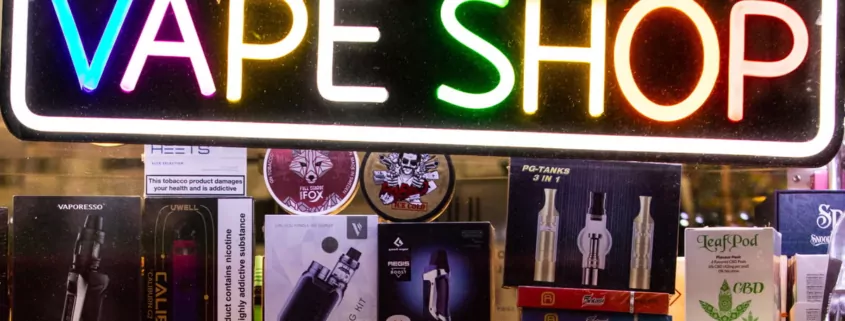Vape Shops in England Rises by Nearly 1,200% in a Decade
The retail landscape for vaping products in England has undergone a phenomenal expansion over the past ten years. New research tracking changes in high street amenities reveals a dramatic surge in the number of dedicated vape shops, with an increase approaching 1,200% between 2014 and 2024. This rapid proliferation indicates a significant shift in consumer demand and retail presence for e-cigarette products across the country, with notable patterns in their geographical distribution and concentration.
The study, conducted by researchers at Health Equity North using Ordnance Survey data, meticulously tracked the rise of these specialist retailers. The findings illustrate a swift market maturation, moving from a niche presence to a near-ubiquitous feature on English high streets.
The Scale of Growth
The data highlights a remarkable trajectory in vape shop numbers. Key statistics illustrating this growth include:
- Widespread Presence: In 2014, vape shops were relatively uncommon. Only 33.8% of the 317 local authorities in England had at least one dedicated vape retail outlet. Fast forward to 2024, and this figure has jumped dramatically to 97.2%, meaning nearly every local authority area in England now hosts at least one vape shop.
- Increased Density: The concentration of vape shops within local authority areas has also intensified significantly. In 2014, less than 1% of local authorities in England had ten or more vape shops within their boundaries. By 2024, this proportion had surged to 28%. This indicates not just a wider spread but also a deepening of market penetration in many areas, with multiple vape shops now competing in individual towns and city districts.
This near 1,200% increase over the decade underscores the rapid consumer adoption of vaping products and the corresponding retail industry expansion to meet this demand. The transition from a novel product category to a mainstream retail presence has been exceptionally swift.
Geographical Distribution
Beyond the overall national increase, the research uncovers distinct patterns in the geographical distribution of vape shops across England, revealing notable regional and socio-economic disparities:
- North-South Disparity: The study found a significant regional divide, with twice as many vape shops now located in the North of England compared to the South. This suggests varying rates of market development or potentially different consumer uptake patterns between the regions.
- Concentration in Deprived Areas: A particularly stark finding is the correlation between vape shop density and levels of deprivation. The research indicates there are three times as many vape shops located in the most deprived areas of England compared to the least deprived (most affluent) areas. This concentration raises questions about market targeting and accessibility in different socio-economic contexts.
Professor Clare Bambra, an academic co-director at Health Equity North and professor of public health at Newcastle University, commented on this aspect, noting, “This trend has disproportionately affected the most deprived places in our country. The northern high street now has… twice as many vape shops as the south.”
Vape Shop Density
The study also provided data on local authorities with the highest number of vape shops per 10,000 people in 2024. This metric offers a more granular view of where vape retail is most concentrated relative to population size. The top local authorities included:
- City of London, London: 4.6 vape shops per 10,000 people. (This is a unique area with a very small residential population but extremely high daytime commuter and worker numbers, which likely skews this particular density figure).
- Blackburn with Darwen, North West: 1.7 vape shops per 10,000 people.
- Preston, North West: 1.6 vape shops per 10,000 people.
- Blackpool, North West: 1.2 vape shops per 10,000 people.
- Bolton, North West: 1.2 vape shops per 10,000 people.
- Lincoln, East Midlands: 1.2 vape shops per 10,000 people.
- Thanet, South East: 1.2 vape shops per 10,000 people.
- Chesterfield, East Midlands: 1.1 vape shops per 10,000 people.
- Hyndburn, North West: 1.1 vape shops per 10,000 people.
- Derbyshire Dales, East Midlands: 1.0 vape shops per 10,000 people.
This list prominently features several areas in the North West of England, aligning with the broader finding of higher vape shop concentrations in the North. These density figures provide a clearer picture of market saturation at a local level.
Factors and Implications of Rapid Expansion
While the research focuses on mapping the growth, several factors likely contribute to this rapid expansion of vape shops. The increasing popularity of vaping as an alternative to traditional smoking, coupled with a diverse and evolving product range (from basic starter kits to advanced mods and a vast array of e-liquid flavors), has fueled consumer demand. Entrepreneurial activity has risen to meet this demand, with vape shops becoming a common sight on many high streets.
The implications of this rapid growth are multifaceted. For the vaping industry, it signifies a maturing market with increased competition. For local authorities and urban planners, it presents challenges and considerations regarding retail mix, high street vitality, and the regulation of a rapidly expanding sector. The concentration in certain areas also prompts further analysis into local market dynamics and consumer behaviors.
The government has acknowledged the changing nature of high streets and mentioned initiatives aimed at regeneration and bringing vacant properties back into use. While not directly addressing vape shop proliferation, these broader policies could influence the future development of retail spaces.
In conclusion, the data unequivocally shows that vape shops have become a significant and rapidly established feature of England’s retail environment over the last decade. Their growth from a handful of outlets to a near-ubiquitous presence, with specific concentrations in the North and more deprived areas, marks a profound shift in the commercial landscape surrounding nicotine products.
- Is It Illegal to Vape or Smoke While Driving in Massachusetts? - August 5, 2025
- Austria Plans to Ban Disposable E-Cigarettes - August 5, 2025
- Vaping vs. THC Drinks: Which Cannabis Option Is Right for You? - August 4, 2025









